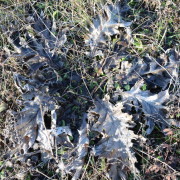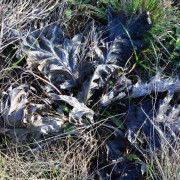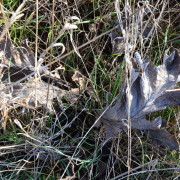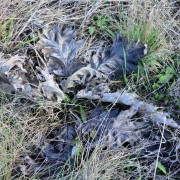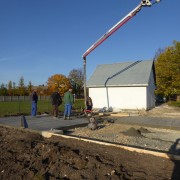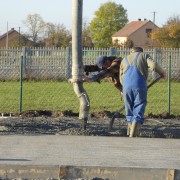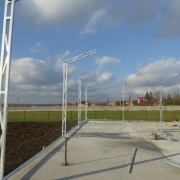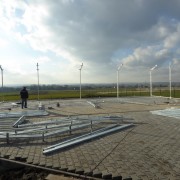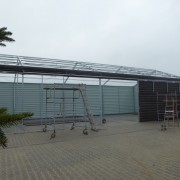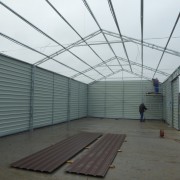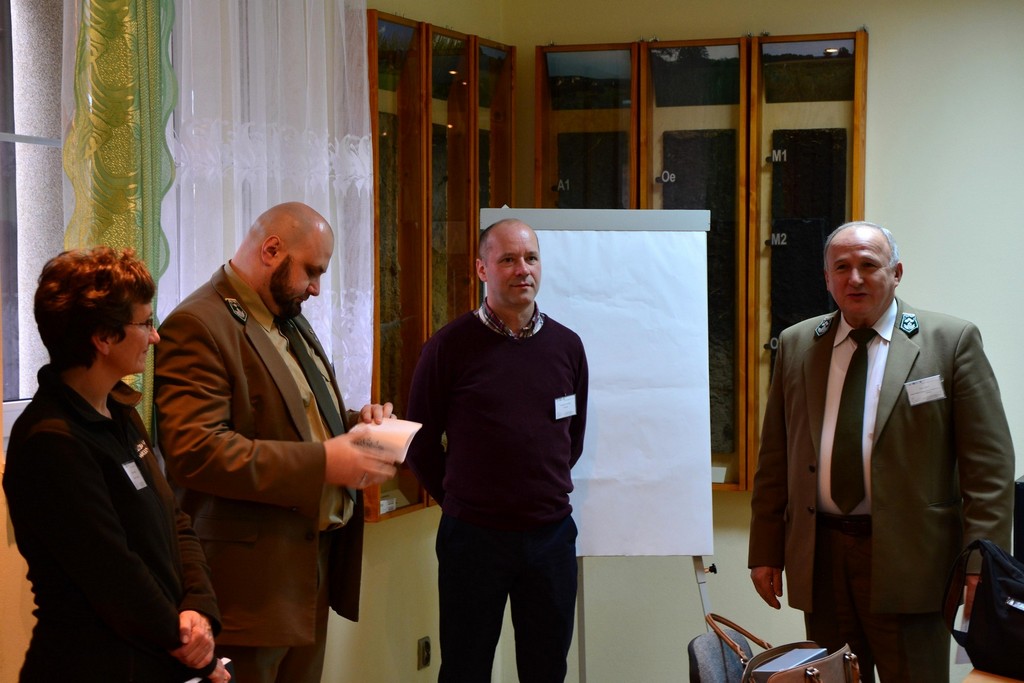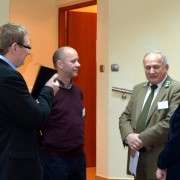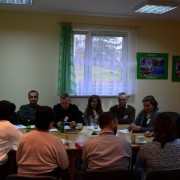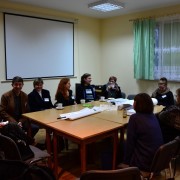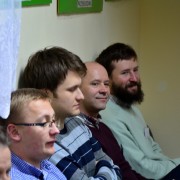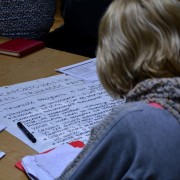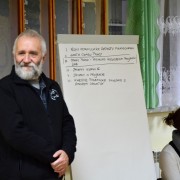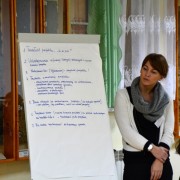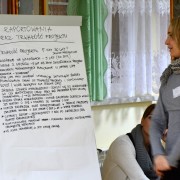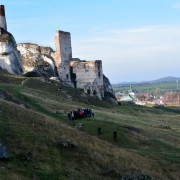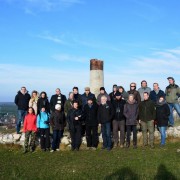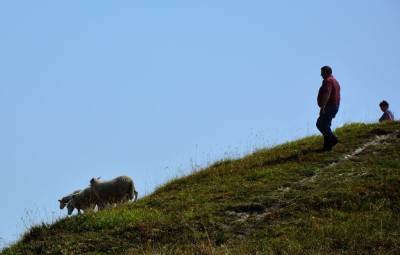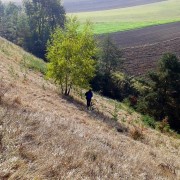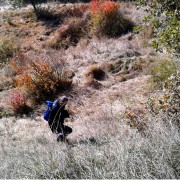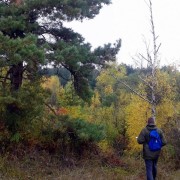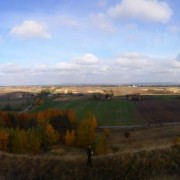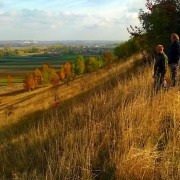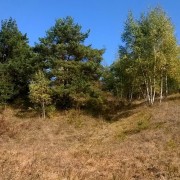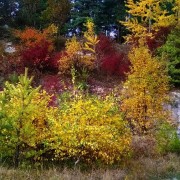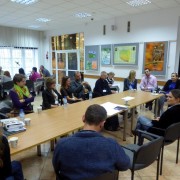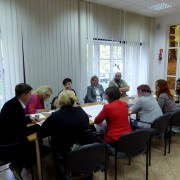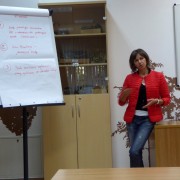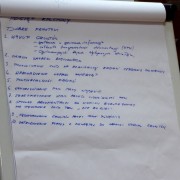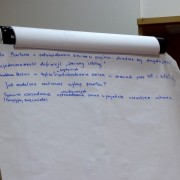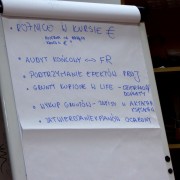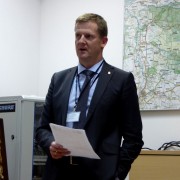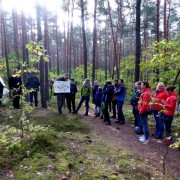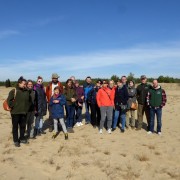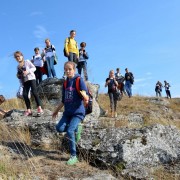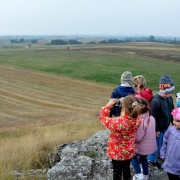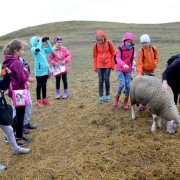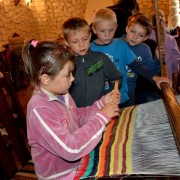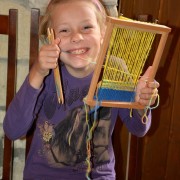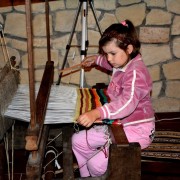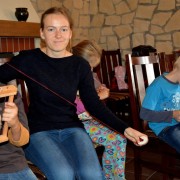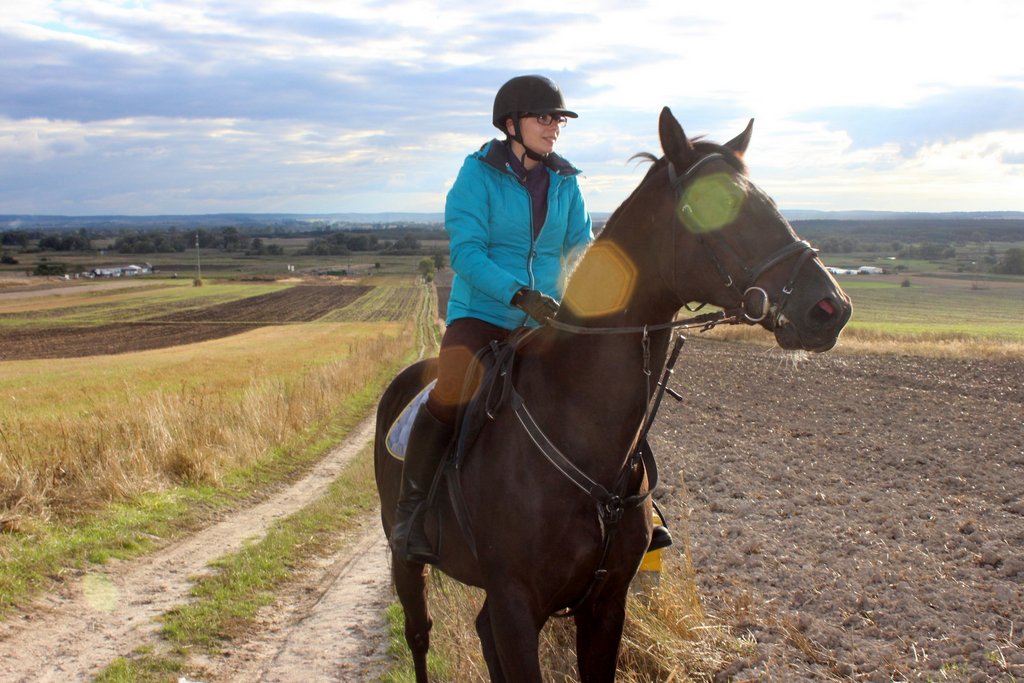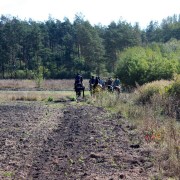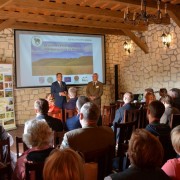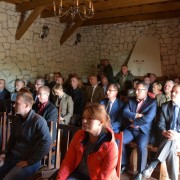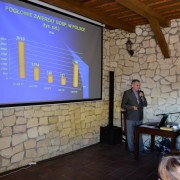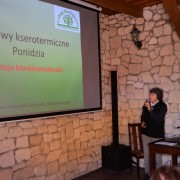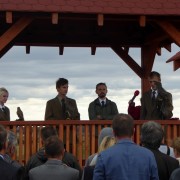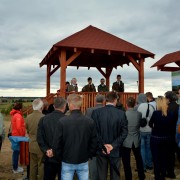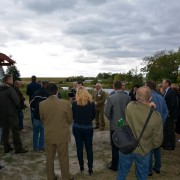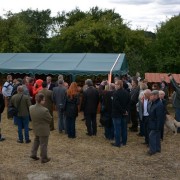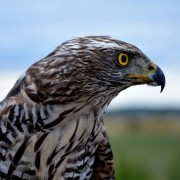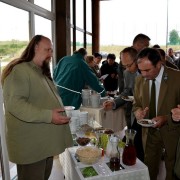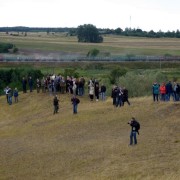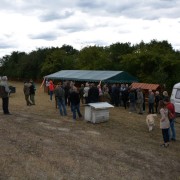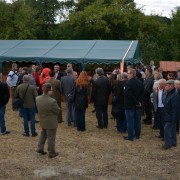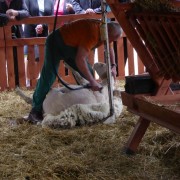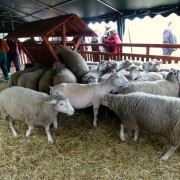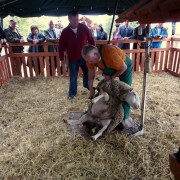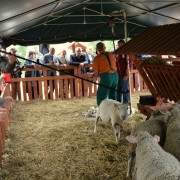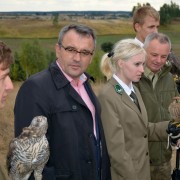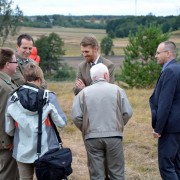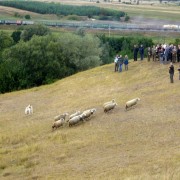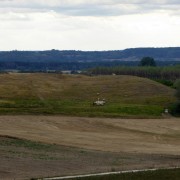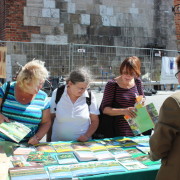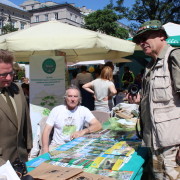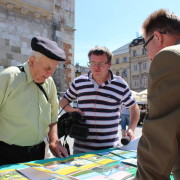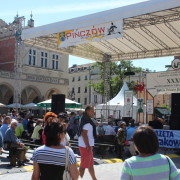News
Carlina onopordifolia Besser appeared in a new location
Until recently, only 4 sites of Carlina onopordifolia were known in Ponidzie region. Thanks to one of our associates, Mr Jerzy Bink, we know there is one more site where this plant can be found. It is difficult to speak of a new site as the new area is only 150 m off the already known area and this is within this species' propagation distance. It can be claimed, however, the plant has expanded its reach significantly. This proves a relatively good condition of the population on the Nida river despite grassland overgrowth. We hope our efforts with respect to active protection (shrub removal and grazing) will result in further expansion of this rare plant.
Finishing works related to the construction of an amenity and garage building in the form of a tent hall in Krzyżanowice have been pending
Finishing works related to the construction of an amenity and garage building in the form of a tent hall in Krzyżanowice have been carried out. The hall is designed for storing a tractor and accompanying machines purchased within LIFE+ project. It will be 152 m2 long and 5.30 m maximum eaves high.
The ground floor walls will be made from steel and the roof from a plastic (tarpaulin).
The photos present hall construction stages.
The second meeting of teams performing LIFE projects
Several dozen people from various parts of Poland and long discussions devoted to the projects implemented, to the regulation interpretation, reports and settlements, inspections and the „afterlife” of projects after the EU funding is over. This was the course of the second meeting of teams performing LIFE projects. It was held on 3 and 4 December at the feet of the castle in Smoleń, in welcoming interiors of the Educational and Scientific Centre, belonging to the Silesian Landscape Park Complex.
We came from various parts of Poland to discuss the finance, performance and reporting, as well as project sustainability and settlements in three teams in an open formula. This exchange of experience was even more valuable as the progress of different project differs, from the ones in their initial phase, through the ones which submitted their midterm reports, to the ones awaiting approval of their final settlement.
As the financial settlement forms were changed, the information we could obtain from more experienced colleagues is impossible to overestimate. How to settle remuneration? How to cope with dishonest vendors and contractors? How to document project sustainability? The answers to those and many other questions were sought together, also thanks to the presence of the EU Monitor, Mr Stanisław Tworek.
Our group was most interested in exchanging experience related to sheep grazing and protection of xerothermic grassland. Similar projects are performed in the voivodeship of Silesia and Lesser Poland. This is why the trip and site inspection to the flock grazing site in Olsztyn near Częstochowa was even more attractive for us. We could observe how efficient the sheep are with respect to protecting xerothermic grassland against expansion of other plants.
Talk to Aleksandra and Waldemar Siepracki who grazed sheep in Ostoja Stawiany
Have you bred sheep before?
We used to have some animals but a long time ago and it was not any large farm.
This summer you grazed 30 sheep and this is a true flock. Did you not have any problems with them?
The animals are like people. If you treat them right, they are also quiet. It turned out soon that the flock had one female leader. When she bleated, they all obeyed and when she went, they all followed. People came, watched and asked questions. The whole families came. It became clear that the flock of sheep was attractive not only for children but also adults.
This season there will be new sheep…
The young will come but they will also become attached to a human. One week after they came I could call them and they would come. I must admit I got attached to them. I seam to miss something. I am sad without them. The dog is also sad.
Did the dog get attached to the flock?
That is obvious. He would run after them and when they fell into a hole, the dog led them out. They were so calm. When we spread a line, they knew they could not cross it and would go one by one in a line.
Are you willing to continue sheep growing after LIFE project finishes?
That is obvious. And I am going to expand the flock. I own meadows so I will be able to graze them not only on the grassland. I will erect a sheepfold and they will have a place to stay in winter. A man learns. I learned to form hooves and I will learn everything.
But you were not eager to try shearing….
You may cut a sheep and the shearer said it was a nervous breed.
Was it worthwhile participating in the project?
It was the first season and I must admit we were apprehensive. What it all will be like and if nothing bad happens to the sheep, if they do not fall sick, if no dogs frighten the flock or attack it, but the season is over and everything was all right. My colleagues first laughed but today they are all interested in the project and sheep (Aleksandra adds).
Preparation for tree felling
The preparatory works on the plots covered with the project to protect thermophilic grassland were completed. The sunny weather was conducive to field works. During a site inspection we visited the posts where the sheep grazing is planned. We counted trees and shrubs in the habitats which will be felled. Mostly, those are seedlings and small trees, with diameter not exceeding 15 cm. Before the woodcutters start their work, we had to confirm which trees and shrubs grew in the habitat and what the grassland condition was. Incidentally, we discovered several instances of blooming Carlina acaulis (stemless carline thistle) and Carlina onopordifolia Besser.
Except for one sand-grown grassland, all the other xerothermic grasslands are included in the protection task plan for Natura 2000 Nida Valley and Ostoja Kozubowska, approved by the Director General for Environmental Protection in Kielce. Thanks to that, according to the Wildlife Protection Act, there is no need to obtain a permit for tree felling and shrub removal.
Meeting of LIFE NATURA project Beneficiaries.
The major themes of the meeting of LIFE NATURA project Beneficiaries, held on 1 and 2 October this year in the seat of Kampinos National Park in Izabelin, included the final reports, settlements with the National Fund for Environmental Protection and Water Management and the methods to minimise FX risk between EUR and PLN.
The conference, apart from our representatives, was attended by the representatives of e.g. the National Fund for Environmental Protection and Water Management, Regional Directorate for Environmental Protection in Krakow, Katowice and Szczecin, Natural Landscape Park Complex for the Voivodeship of Silesia, Forest Research Institute, Słowiński, Wigierski, Pieniński and Kampinos National Parks.
The open space formula was a great idea. Such conferences enable to involve all participants in direct dialogue. They deal solely with the most important aspects and lead to accurate conclusions. Thanks to the adopted formula, we could get responses to most of our questions and talk about the legal and accounting details related to LIFE project performance. However, the meeting was primarily a great platform to talk to other Beneficiaries, many of whom have much greater experience.
Educational workshops.
The next stage of educational activities has been completed. Close to 350 children from forms 0 to 6 from Kielce and Kije municipality participated in the workshops lasting for seven days in Samorządowa Instytucja Kultury „Kasztelania” in Kije. During the field part of the workshops the children could watch sheep grazing in Ostoja Stawiany on Sobótczana Mountain and listened to information on thermophilic plants creating xerothermic grassland. They could also see particular plant species. Then, during the class work, they learned about wool applications. Young people tried to use a spindle and a spinning wheel. They tried weaving with pins, rigid heddles and looms. Each group left a colourful strip of woolen textile made by themselves. What they liked most, however, was making bracelets and pompoms which could be taken home.
First mounted patrols.
The first mounted patrols planned for autumn this year have already been done. Having got acquainted with the horses and completing a short warm-up in the paddock of Ludowy Klub Jeździecki in Pińczów, the riders from Oxer club set off. They penetrated the area on Pińczowski Projection where sheep are to graze next year. Mounted patrols in autumn landscape were a chance to get acquainted firstly with LIFE+ project, wildlife conservation, natural values of xerothermic grassland and geological history of Nidziańska Basin. Two illegal waste dumps were detected during the patrol which were reported to the ground owner.
The opening conference of the Life 13 NAT/PL/000038 Project
On 8th September 2015 in the headquarters of the Local Cultural Institution “Kasztelania” in Kije the opening conference of the LIFE13 NAT/PL/000038 Project titled „The protection of valuable natural habitats in Ponidzie” took place. It was attended by 85 people, among whom were representatives of all the communities and institutions interested in the project: local government officials, scientists, sheep graziers, and representatives of the National Fund for Environmental Protection and Water Management, the State Forests, the National Research Institute of Animal Production, Polish Union of Sheep-Farmers as well as the media and environmental non-governmental organisations.
At the conference, the head of the Complex of Ponidzie and Świętokrzyskie Region Landscape Parks Tomasz Hałatkiewicz presented the aims and objectives of the project while professor dr hab. Małgorzata Jankowska – Błaszczak (Jan Kochanowski University) and professor dr hab. Tomasz Gruszecki (University of Life Sciences in Lublin) delivered scientific lectures on the subject of the unique flora of Ponidzie region and the impact of sheep and goat grazing on biodiversity of xerothermic grassland environment.
In the outdoor part of the conference the attendees visited Ostoja Stawiany where they were given a chance to familiarise themselves with the infrastructure built under the project and listen to a lecture on birds of prey that inhabit both Ostoja Stawiany and the landscape parks.
An additional attraction prepared by the LIFE team was a sheep shearing demonstration and the tasting of wild plants commonly found in Ponidzie.
Not only did the conference allow for a presentation of the LIFE project but it also served as an opportunity to establish contact between people from various backgrounds working in the field of environmental protection and sustainable development.
Pińczów Day in Kraków
On Thursday 20th August, Pińczów Day was celebrated on the Market Square in Kraków. Since 2007, when the 750th anniversary of the Kraków Location Act was celebrated on Pińczów grasslands, the authorities of Pińczów have been invited to the Folk Art Fair. It’s the largest in Poland presentation of folklore, artistic handicraft and regional traditions, 39th edition of which took place this year.
We were there with our stand, aiming to popularise the natural values of Ponidzie and Świętokrzyskie Region Landscape Parks. We also presented informational and educational materials, including those concerning the Life+ Project „The protection of valuable natural habitats in Ponidzie”. Among the interested visitors were people who had already been to Ponidzie or Świętokrzyskie Voivodeship as well as those who were only planning to go there. Some countrymen born in Pińczów or the surrounding areas, interested to learn about the changes that occurred in their hometown were also present. Both the on stage presentations and conversations at our table lasted until the evening.













